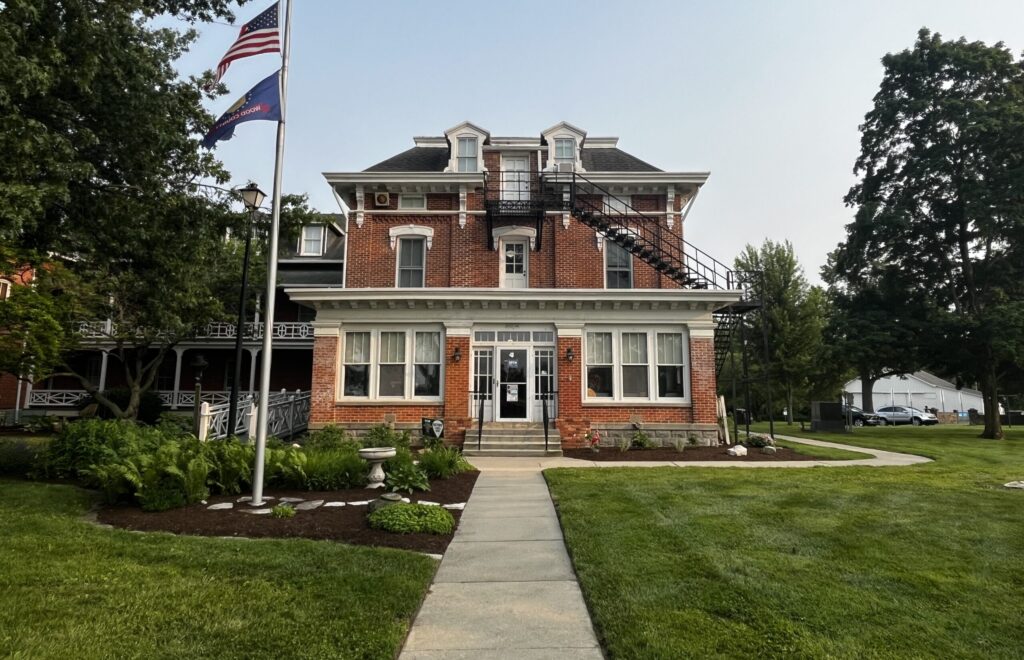By STEPHA POULIN
BG Independent News
Adolf Hitler reportedly had a soft spot for the animated classic “Snow White and the Seven Dwarfs,” a local authority on wartime cinema told an audience at the Wood County Museum earlier this week.
Lecturer Joy Bennett kicked off the first in a four-part summer lecture series on World War II Tuesday evening. The opening talk offered an exploration of wartime propaganda through the lens of classic cinema.
The BGSU graduate brought energy and humor to a subject that she noted had once lulled audiences to slumber. “I was surprised this many people showed up,” she said. “Usually when I start talking about my thesis, people fall asleep.”
Bennett, curator and archivist at the Hancock Historical Museum, drew from her graduate thesis comparing Nazi Germany’s propaganda films to Hollywood’s wartime productions.
Her presentation wove together analysis and behind-the-scenes history of influential films and filmmakers, with particular emphasis on the 1942 classic “Casablanca.”
“Propaganda, immigration, romanticism, resistance. It’s all in this movie … It’s more than just a love story,” she said.
Bennett explained how, while the Nazi regime co-opted cinema into state propaganda – with directors reduced to civil servants and content filtered through Joseph Goebbels – American studios worked more subtly with the United States Office of War Information to craft films that blended patriotic messaging with entertainment.

She highlighted the unique moral urgency felt by Hollywood’s Jewish executives, many of whom were immigrants or children of immigrants. Warner Bros., for example, released the first openly anti-Nazi film “Confessions of a Nazi Spy” in 1939, two years before “Casablanca” and before the U.S. entered the war.
Bennett touched on how émigré artists, some fleeing Nazi persecution, reshaped American film. Directors like Billy Wilder and Fritz Lang, and actors like Peter Lorre and Conrad Veidt, brought with them the darker tonalities of Weimar cinema. “Entire genres, like film noir, owe their existence to these European voices,” she noted.
She drew attention to the real-life refugee backgrounds of actors, how the authentic emotion in scenes such as the singing of “La Marseillaise” was rooted in lived experiences. “Once you know their backstories,” Bennett said, “you can see how real it is for them.”
The talk also spotlighted women’s roles in wartime Hollywood, both onscreen and off. Greer Garson’s performance in “Mrs. Miniver” was credited with boosting Allied morale, even earning Winston Churchill’s praise. Meanwhile, actress Merle Oberon used her fame for activism, working with war relief organizations and publicly denouncing Nazism. Veronica Lake, famous for her “peekaboo” hairstyle, altered her look in a PSA to promote factory safety for female workers.
Bennett also discussed the Hollywood Canteen, a nightclub organized by Bette Davis and John Garfield to provide free meals and entertainment to enlisted men. “It was a huge morale boost,” Bennett said, describing how servicemen might be served coffee by Judy Garland or dance with Rita Hayworth.
After the lecture, attendees were invited to explore the museum’s newly opened WWII exhibit. A self-guided walking tour on the museum grounds was also available, offering additional context about local history.
Attendee Flossie Wojtkiewicz and her father, Dennis, are newcomers to the museum lectures and eager to visit again. “I was very impressed,” Flossie said. “We just donated $40.”
For more on the Wood County Museum’s events, visit WoodCountyHistory.org.





